Sebring Convertible V6-2.5L SOHC 24 Valve (1996)

Air Bag: Description and Operation
Driver and Passenger Airbags
WARNING: Never disassemble the driver or passenger airbag module, there are no serviceable parts within the module.
DESCRIPTION
It contains the airbag cushion and its supporting components. The airbag module contains a housing in which the cushion and inflator are attached
and sealed.
OPERATION
The driver side inflator assembly is mounted from the back of the module housing. When supplied with the proper electrical signal, the inflator
assembly produces a gas and discharges it directly into the cushion. A protective cover is fitted to the front of the Driver Airbag Module and forms
a decorative cover in the center of the steering wheel. The Driver Air-bag Module is mounted directly to the steering wheel. The passenger inflator
assembly is within the module housing. The module is mounted to the instrument panel retainer and support structure. When supplied with the
proper electrical signal the inflator will produce a gas and discharge it directly into the cushion. A protective cover is fitted into the instrument
panel over the airbag module and forms a decorative cover.
The Passenger Airbag (PAB) Module consists:
^
Inflator assembly
^
Reaction canister
^
Airbag Pillow
^
Deployment door
The PAB module is mounted to the instrument panel plastic retainer and steel reinforcement assembly. When supplied with the proper electrical
signal, the inflator produces gas and discharges it directly into the pillow. The deployment door will hinge, allowing the pillow to fully inflate.
LOCATION
The Driver Airbag Module located in the center of the steering wheel is the most visible part of the system.
The Passenger Airbag Module is located beneath the decorative cover of the instrument panel, facing the passenger seat.
